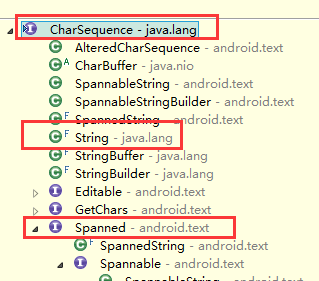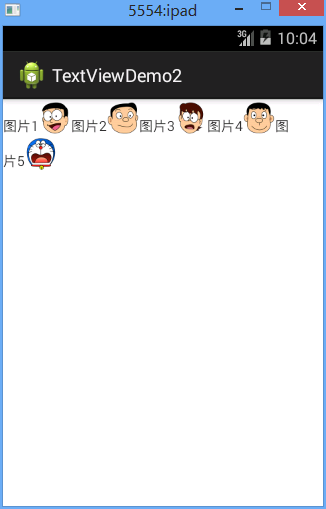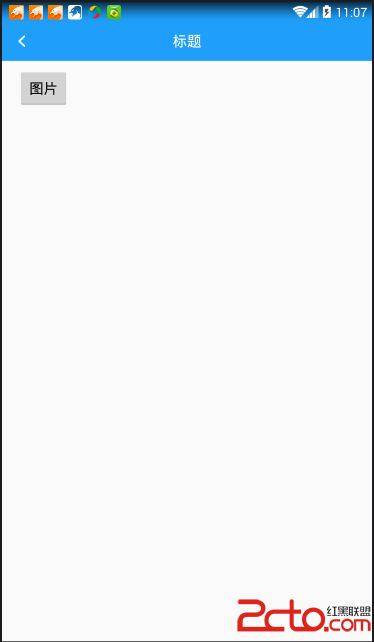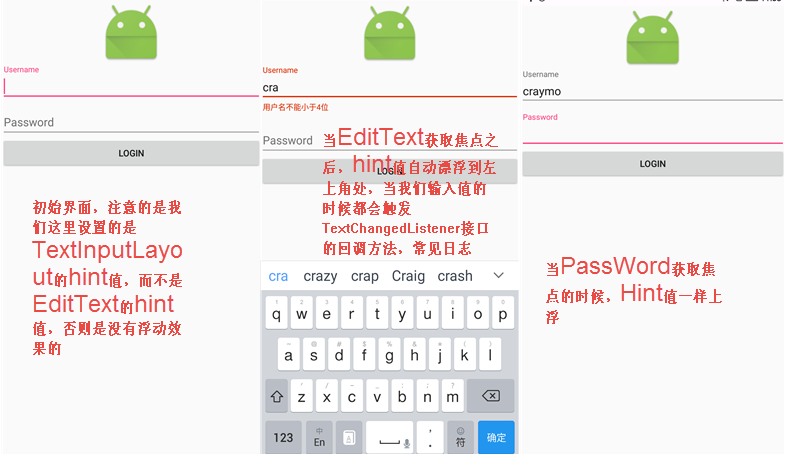編輯:關於Android編程
一、簡介

在這裡實現圖文混合編排使用的是:TextView中預定義的類似Html的標簽
二、方法
* 1、設置好html標簽的文本
String html="<font>圖片1</font><img src='image1'/>";
html+="<font>圖片2</font><img src='image2'/>";
html+="<font>圖片3</font><img src='image3'/>";
html+="<font>圖片4</font><img src='image4'/>";
html+="<font>圖片5</font><img src='image5'/>";
* 2、為之前的文本聲明Html.fromHtml,方便TextView解析為html標簽
tv_one.setText(Html.fromHtml(text1));
因為有圖片,我們要獲取圖片源,所以上面的那句不行;
所以如下:
CharSequence text=Html.fromHtml(html, new ImageGetter() {中間省略}, null);
new ImageGetter() {中間省略}這部分比較復雜,看實例代碼吧,實質就是取到R文件中圖片對應的ID
* 3、將CharSequence字符串序列的文本text插入到TextView控件中即可
tv_textAndImage.setText(text);
這裡是charSequence是因為Html.fromHtml方法的返回值是Spanned類型,
看下下面的類圖特別好懂:

三、代碼實例
效果圖

代碼
fry.ActivityDemo2
package fry;
import java.lang.reflect.Field;
import com.example.textViewDemo1.R;
import android.app.Activity;
import android.graphics.drawable.Drawable;
import android.os.Bundle;
import android.text.Html;
import android.text.Html.ImageGetter;
import android.widget.TextView;
public class ActivityDemo2 extends Activity{
private TextView tv_textAndImage;
@Override
protected void onCreate(Bundle savedInstanceState) {
// TODO Auto-generated method stub
super.onCreate(savedInstanceState);
setContentView(R.layout.activity02);
setTitle("TextViewDemo2");
tv_textAndImage=(TextView) findViewById(R.id.tv_textAndImage);
//第一步,設置文本
String html="<font>圖片1</font><img src='image1'/>";
html+="<font>圖片2</font><img src='image2'/>";
html+="<font>圖片3</font><img src='image3'/>";
html+="<font>圖片4</font><img src='image4'/>";
html+="<font>圖片5</font><img src='image5'/>";
//第二步,告訴TextView控件這是html,並且獲取文本中的圖片源
CharSequence text=Html.fromHtml(html, new ImageGetter() {
public Drawable getDrawable(String source) {
// TODO Auto-generated method stub
//根據圖片資源ID獲取圖片
//getResources就是去找項目裡面的res文件夾
Drawable drawable=getResources().getDrawable(getDrawableResurceID(source));
//一定要加上邊界這部分代碼。要不然drawable會因為信息不完整讀不出來圖片
//分別是left top width height
drawable.setBounds(0, 0, drawable.getIntrinsicWidth(), drawable.getIntrinsicHeight());
return drawable;
}
}, null);
//第三步、將CharSequence字符串序列的文本text插入到TextView控件中即可
tv_textAndImage.setText(text);
}
/**
* 獲取圖片的資源ID
* @param imageName 圖片的名稱
* @return 圖片對應的ID
*
*/
private int getDrawableResurceID(String imageName){
//利用反射機制取得圖片的id
/*
* 其實是找com.example.textViewDemo1.R.drawable.image1的值,也就是
* public static final int image1=0x7f020001;
* 也就是0x7f020001
* 例如image1,返回的就是0x7f020001
*/
try {
Field field=R.drawable.class.getField(imageName);
return Integer.parseInt(field.get(null).toString());
} catch (Exception e) {
// TODO Auto-generated catch block
e.printStackTrace();
}
return 0;
}
}
/textViewDemo1/res/layout/activity02.xml
<?xml version="1.0" encoding="utf-8"?>
<LinearLayout xmlns:android="http://schemas.android.com/apk/res/android"
android:layout_width="match_parent"
android:layout_height="match_parent"
android:orientation="vertical" >
<TextView
android:id="@+id/tv_textAndImage"
android:layout_width="match_parent"
android:layout_height="wrap_content"
/>
</LinearLayout>
以上就是本文的全部內容,希望對大家的學習有所幫助,也希望大家多多支持本站。
 狀態欄一體化及其帶來的軟鍵盤自適應問題
狀態欄一體化及其帶來的軟鍵盤自適應問題
狀態欄一體化及其帶來的軟鍵盤自適應問題應項目需求才開始了解狀態欄一體化的問題,作為一個android新手,之前從未接觸過。第一反應是網上搜索,不得不說網絡確實給我帶來很大
 Android如何自定義EditText下劃線?
Android如何自定義EditText下劃線?
曾經做過一個項目,其中登錄界面的交互令人印象深刻。交互設計師給出了一個非常作的設計,要求做出包含根據情況可變色的下劃線,左側有可變圖標,右側有可變刪除標志的輸入框,如圖
 每一位Android開發者應該知道的Android體系架構和開發庫
每一位Android開發者應該知道的Android體系架構和開發庫
Android 的體系架構鼓勵組件重用,允許開發者發布共享 Activity、Service 並且訪問其他應用程序的數據,還可以根據開發者制定的安全限制
 Android進階——Material Design新控件之TextInputLayout
Android進階——Material Design新控件之TextInputLayout
引言Android L之前,很多時候我們在使用EditText輸入時,希望給及時糾正用戶錯誤的格式輸入,常常會監聽一些事件,然後給出一些提示語言,而顯示提示語言的有可能是